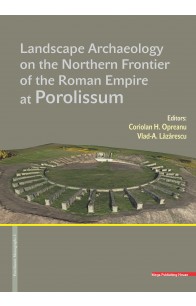Rezultate căutare pentru 'Ioan Oprea'
„The frontiers of the Roman Empire, over 5000 km long, stretch from the Atlantic coast of Scotland, along the Rhine and the Danube, also enclose the Banat region and Transylvania, then going down along the Oriental Carpathians to the Black Sea; from the southern coast of the Black Sea they continue towards the Near East until the Red Sea; then, in North Africa, they line the edge of the Sahara desert until the Atlantic coast of Morocco. Over this entire area, visible traces of fortifications, roads and settlements are still preserved, but numerous monuments still lay hidden underneath the earth. Despite the fact that the Roman frontiers crossed regions with different relief and climate, they constitute a whole in that they were designed to protect Roman territories. The research of these monuments and the preservation policy regarding them was and is unequal in the various presentday states on whose territory traces of the Roman frontier are to be found. Consequently, in the ‘80s of the 20th century, the idea of globally protecting the Roman frontiers, viewed as a unitary monument, was met. In 1987, Hadrian’s Wall in United Kingdom was declared a UNESCO monument. It was followed in 2005 by the German-Raetian sector, on which occasion the UNESCO committee decided to set up the ‘Frontiers of the Roman Empire’ site. (...)
This project through its complexity generated an interdisciplinary approach of the proposed subject stimulating such future attempts in the archaeological research field. By using the latest technical methods of non-destructive investigation the project did not damage the stratigraphy of the archaeological site obtaining instead a high amount of data otherwise time consuming judging from the archaeological excavations perspective contributing also to the preservation of the cultural heritage.” - Introduction
SOMMAIRE
Alexander Baumgarten, Le reste comme problème de la philosophie
I. Figurer le reste
Luigi Tassoni, La poetica delle somiglianze. Milo De Angelis dalle rovine del soggetto alle tracce del riconoscimento
Corin Braga, Le centre structurel et ses restes
Giovanni Rotiroti, Per una poetica e una politica dei resti a partire da Urmuz: il caso di Tristan Tzara, Eugène Ionesco, Paul Celan e Gherasim Luca
Antonio Patraș, The Anecdote in The History of Romanian Literature from Its Origins to the Present
Ligia Tudurachi, « Jouets », « boîtes », « reliques ». Fascination du petit chez Hortensia Papadat-Bengescu
George Alexandru Condrache, The Residual Forms in Contemporary Central European Literature. Two Case Studies: Bohumil Hrabal and Ádám Bodor
II. Le continent de la non-lecture
Horea Poenar, Glitches of the Archive: On the Relation Between Memory and the Commons
Catherine Gravet, Dépouiller des archives pour éditer des textes « résiduels » : le cas Alexis Curvers
Florin Oprescu & Monica Oprescu, Mateiu Caragiale – Through the Leftovers’ Glass. From the Journal to Ephemerides
Gabriela Glăvan, Communist Leftovers: The Forgotten Books of Gellu Naum
Eugen Radu Wohl, Ion D. Sîrbu’s Anthumous Works as (Re)valuable Residues
Levente T. Szabó, Dilettantism as a Moral Panic. Recovering a Forgotten Discourse of Hungarian Literary Modernization]
Corina Croitoru, Le résidu du résidu : ombres de la poésie roumaine de guerre
Roxana Patraș, When All That Rests Is Literature: Traces, Transcriptions and Remnants of Great Speeches
Arina Neagu, Une autre approche sur les mémoires roumains de prison : le caractère résiduel de « l’indicible concentrationnaire »
Barbara Miceli, How to Turn a Forgotten Figure of American History into a National and Gender Emblem: Joyce Carol Oates’s Treatment of Mary Jo Kopechne in Black Water
III. Identités en marge
Marie Vrinat-Nikolov, Les langues ignorées de l’espace littéraire bulgare
Annalisa Cosentino, La boemia altrove
Marius Popa, Le classicisme français dans la critique littéraire de la génération roumaine de 1848. Radiographies d’un « malentendu »
Lavinia Sabou, The Travel Accounts We Don’t Write About. Eastern European Ways of Mapping the World
Ruxandra Cesereanu, Societal Metabolism and “Excretion”: Towards a Typology of Marginals (The Fiction of Venedikt Yerofeyev, Alexander Zinoviev and Roberto Bolaño)
IV. Survivances
Monica Fekete, La rigenerazione del poema cavalleresco: da centro epico-narrativo a margine del moderno, da trionfo idealistico a spazio del romanzo contemporaneo
Laura Marin, Survivances du neutre
Márta Zabán, Residual Nationalism. The Nineteenth-Century Hungarian Folk Drama as a Reinterpretation of European Theatrical Nationalism. Pour une politique du résiduel en littérature
Ioana Bot, Gli esordi dimenticati della stilistica: Leo Spitzer, censore dei soldati italiani nei campi di prigionia della Prima Guerra Mondiale
Elena Crașovan, (Mis)readings of Contemporary Magical-Realist Fiction in the Context of Romania’s 2000 Literary Generation. The Case of Bogdan Popescu
Adriana Stan, Monuments of Literature, Scraps of Criticism
V. Entretiens: Ioana Bot, What’s Left? A Discussion on the Remains of Writing – and the Remains of Living – with Two European Authors
„Cartea este un model de tratare a unei vechi instituţii din Țara de Sus a Moldovei, până la ocuparea Bucovinei de către Habsburgi, în 1775. Perioada tratată cuprinde deceniile de final ale Evului Mediu şi aproape două secole din Epoca Modernă.” (Ioan-Aurel Pop)
„Vornicii de Câmpulung (Moldovenesc) au avut de îndeplinit un rol deosebit la fruntariile de vest ale Țării Moldovei. Din sursele istorice cercetate, reiese că aceştia erau răspunzători de paza hotarelor Moldovei. Tot ei au trebuit să întreţină relaţii politico-diplomatice şi economice bune cu juzii-primari din oraşul Bistriţa, pentru ca schimburile şi tranzacţiile economice dintre Transilvania şi Moldova să fie fructuoase şi lipsite de impedimente. Tot în sarcina vornicilor figura urmărirea, prinderea şi pedepsirea hoţilor care au activat la hotarul dintre Moldova şi Transilvania. Nu în ultimul rând, vornicii de Câmpulung, pentru a îndeplini atribuţiile cu care au fost investiţi de către domnie, au avut în subordinea lor un aparat administrativ complex, format din vameşi, namestnici, vatamani de sat, dieci, oameni buni şi bătrâni etc.” (din „Introducere”)






